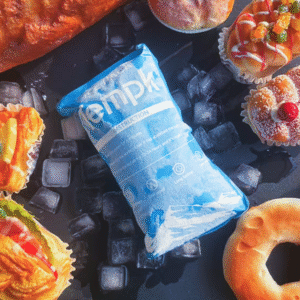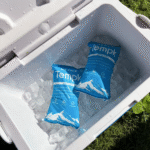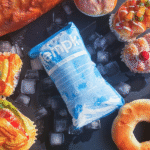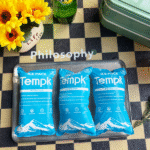Ist Trockeneis für den Kühlkettenversand besser als Gel-Eisbeutel??
Der Versand verderblicher Waren erfordert eine sorgfältige Temperaturkontrolle. Many shippers wonder “Is dry ice better than gel ice packs?” for keeping products safe. Trockeneis sorgt für extrem kalte Temperaturen (etwa –109,3°F) und eignet sich ideal für Tiefkühltransporte über große Entfernungen. Gel -Eisbeutel, auf der anderen Seite, Halten Sie eine moderate Kühlung zwischen 2 und 8 °C aufrecht, Dadurch sind sie für Gegenstände geeignet, die nicht gefrieren dürfen. Dieser Leitfaden vergleicht ihre Leistung, Sicherheit, kosten, Nachhaltigkeit, und Trends, die Ihnen bei der Auswahl der besten Kühllösung helfen.
Was unterscheidet Trockeneis von Gel-Eisbeuteln?? Erfahren Sie mehr über ihre Zusammensetzung, Temperaturbereiche und wann jeder geeignet ist.
Welche Option ist sicherer und einfacher zu handhaben?? Informieren Sie sich über Vorsichtsmaßnahmen bei der Handhabung und behördliche Anforderungen.
Wie lassen sich Kosten und Umweltauswirkungen vergleichen?? Bewerten Sie langfristige Ausgaben und Nachhaltigkeitsaspekte.
Was sind die 2025 Trends bei Kühlkettenlösungen? Entdecken Sie Innovationen wie Phasenwechselmaterialien und intelligente Sensoren.
Was unterscheidet Trockeneis von Gel-Eisbeuteln??
Dry ice and gel ice packs differ fundamentally in composition and temperature performance. Dry ice is solid carbon dioxide that sublimates directly into gas at –78.5 °C (–109,3°F), delivering extreme cold for shipments that must remain frozen. Gel ice packs contain water or phase change materials that freeze near 0 °C and slowly absorb heat as they melt, maintaining moderate temperatures. This distinction makes dry ice ideal for products like ice cream, gefrorenes Fleisch, oder biologische Exemplare, while gel packs suit fresh produce, dairy products and pharmaceuticals requiring 2–8 °C.
Understanding their properties and uses
Both cooling methods rely on phase change, but they work differently:
| Aspekt | Trockeneis | Gel -Eisbeutel | Was es für Sie bedeutet |
| Zusammensetzung | Solid carbon dioxide sublimates directly into CO₂ gas | Water based gel or phase change materials freeze near 0 °C | Dry ice yields extreme cold; gel packs offer moderate, stabile Kühlung |
| Temperaturbereich | Provides ultra low temperatures (–78.5 °C/–109.3 °F) | Maintains 2–8 °C for up to 48 H | Choose dry ice for items needing deep freezing; Gelpackungen für gekühlte Waren |
| Dauer | Can keep items frozen for several days with proper insulation | Holds temperature for 24–48 h depending on pack size and insulation | Dry ice lasts longer but depends on container insulation; gel packs suit short shipments |
| Handhabung | Erfordert isolierte Handschuhe, Zange, and ventilation due to frostbite risk | Sicher zu handhaben, keine spezielle Ausrüstung erforderlich | Consider user safety and training in your operations |
| Vorschriften | Als Gefahrgut eingestuft; shipping requires labeling, weight limits and ventilation | Generally unregulated and easier to ship | Compliance affects cost and logistics planning |
Dry ice’s sublimation and extreme cold make it indispensable when you must keep products frozen solid. Jedoch, its handling risks and regulatory requirements mean it isn’t always the best solution.
Explaining dry ice vs gel ice packs in simple terms
Imagine a road trip where you need to keep ice cream frozen and sandwiches cool. Dry ice is like a portable deep freezer—it keeps ice cream rock solid for days but needs careful handling so you don’t “burn” yourself or fill the car with CO₂ gas. Gel ice packs are like a refrigerator pack—they keep sandwiches cold and safe without freezing them. They’re easier to handle, wiederverwendbar, and won’t give you a frostbite if you accidentally touch them. This analogy captures why the choice depends on what you’re shipping and how long it needs to stay cold.
Why is dry ice considered hazardous compared to gel ice packs?
Safety risks and regulatory requirements
Dry ice’s extreme cold and CO₂ release create unique hazards. Direct contact with bare skin can cause frostbite-like burns. When sealed in airtight containers, the sublimating CO₂ gas can build pressure and cause explosions, which is why shipping carriers require vented packaging and strict labeling. Many couriers restrict dry ice quantities and require Class 9 hazardous material labels, special documentation and weight limits. Because of these hazards, packages containing dry ice must remain vented and cannot be shipped through some services.
Dagegen, gel ice packs pose minimal risks. They are typically non toxic, do not sublimate, and are safe to handle without protective gear. There are no special regulatory requirements for shipping gel packs, making them more accessible for consumers and small businesses.
Practical safety tips for handling dry ice and gel packs
Tragen Sie Schutzausrüstung: Verwenden Sie beim Umgang mit Trockeneis immer isolierte Handschuhe und eine Zange.
Belüftung sicherstellen: Pack dry ice in a well ventilated container to avoid CO₂ buildup.
Verwenden Sie den richtigen Behälter: Never use an airtight container with dry ice, as pressure may build up. Für Gelpacks, choose a container sized to allow adequate cushioning and cold circulation.
Gewicht begrenzen: Follow guidelines for dry ice quantity—equal weight to the payload for 48 hour shipments or 1.5 times the payload for 72 hour shipments.
Überwachen Sie die Bedingungen: Use temperature sensors to track internal temperatures. When using gel packs, replace them if they become too warm or heavy with condensation.
Praktischer Fall: A meal-kit company switched from dry ice to gel packs for overnight deliveries after several customers experienced foggy packaging and frostbite from touching dry ice pellets. The switch eliminated hazards, reduced customer complaints, and simplified shipping compliance without compromising quality.
When is dry ice better than gel ice packs?
Comparing performance for different product categories
Performance depends on the temperature requirements and sensitivity of your products:
Frozen foods and frozen pharmaceuticals: Dry ice is unmatched for preserving items that must remain below freezing. Products like ice cream, gefrorenes Fleisch, or sensitive vaccines require ultra cold temperatures and long transport durations. Dry ice can maintain these temperatures for several days when combined with high quality insulation.
Chilled perishables and medications: Gel ice packs maintain a stable 2–8 °C environment, which is ideal for fresh produce, Milchprodukte, floral shipments, und Arzneimittel, die nicht einfrieren sollten. Gel packs also prevent the “freezer burn” or texture changes that can occur when products partially freeze.
Verbraucherlieferungen: For meal kits and groceries delivered locally, gel ice packs provide safe handling, einfache Entsorgung, und Wiederverwendbarkeit. Dry ice may over cool items, causing liquids to freeze or packaging to crack.
Tisch: Ideal applications of dry ice vs gel ice packs
| Versandart | Dry ice use | Gel ice pack use |
| Gefrorenes Essen (Eiscreme, Meeresfrüchte) | Necessary for deep frozen temperature stability | Nicht empfohlen; cannot reach sub zero temperatures |
| Frische Produkte, Molkerei, Arzneimittel | May over freeze and damage products | Recommended for stable 2–8 °C cooling |
| Langstreckentransporte (48–72 h) | Effective when combined with proper insulation, using equal or greater weight of dry ice than product | Beschränkt; may require multiple gel packs and insulation |
| Consumer-friendly deliveries (Mahlzeiten) | Handling risk and CO₂ gas make it less suitable | Sicher, wiederverwendbar und einfach zu handhaben |
| Biological samples and laboratory research | Preferred due to ultra low temperatures and extended duration | Inadequate; may allow samples to thaw |
Benutzertipps und Empfehlungen
Tailor your solution: Berücksichtigen Sie die Produktempfindlichkeit, travel distance, und gewünschte Temperatur. Use dry ice for deep frozen items and gel packs for chilled goods.
Combine methods when necessary: For shipments that need both cooling ranges, a hybrid approach using gel packs near temperature-sensitive items and dry ice for overall coldness can provide balanced temperatures.
Investieren Sie in hochwertige Isolierung: The performance of both dry ice and gel packs depends heavily on the insulation of the container. High performance liners, Isolierte Trockeneisbeutel, or vacuum-insulated panels help maintain the desired temperature longer.
Praktischer Fall: A seafood exporter shipping crab across the country combined dry ice and gel packs. Gel packs surrounded the crab meat to avoid freezer burn, while dry ice placed on top maintained the overall sub zero environment. This hybrid method preserved texture and ensured regulatory compliance.
What are the cost and environmental considerations?
Comparing costs and reuse potential
Dry ice costs more and is single-use, while gel packs offer longer-term value. Dry ice is a consumable product; its cost includes purchase, Lagerung, Handhabung, and compliance fees. It sublimates completely during shipment and must be replaced for each use. Gel ice packs cost less per use, can be bought in bulk, and are reusable—reducing long-term expenses. Their cost-effective nature is especially important for businesses that ship frequently or offer subscription services.
| Faktor | Dry ice cost | Gel ice pack cost | Was bedeutet dies |
| Purchase price | Höhere Anschaffungskosten | Lower cost per unit and available in bulk | Gel packs lower upfront spending |
| Wiederverwendbarkeit | Einweg; sublimiert vollständig | Wiederverwendbar; can be refrozen many times | Reusability lowers long-term costs |
| Shipping compliance fees | May include hazardous materials surcharges and documentation | No special fees or labeling requirements | Gel packs simplify logistics |
Environmental impacts and sustainability
Trockeneis: Although dry ice sublimes into CO₂—a by product of industrial processes—it still contributes to greenhouse gas emissions when produced and transported. Its manufacturing can be energy intensive. Disposal requires safe venting, and CO₂ emissions must be managed.
Gel -Eisbeutel: Many modern gel packs use biodegradable or recyclable materials and can be refrozen repeatedly. Reusability reduces waste and energy consumption. Jedoch, older gel packs may contain plastics that need proper recycling.
For eco conscious businesses, gel ice packs often align better with sustainability goals. Noch, choosing sustainably sourced dry ice produced from captured CO₂ can reduce the environmental impact of using dry ice.
Practical suggestions for cost and sustainability
Conduct a cost analysis: Calculate your annual shipment volume, required cooling duration, and labor costs for handling and compliance. Determine whether the higher performance of dry ice offsets its cost and regulation.
Implement reusable programs: Offer return or reuse programs for gel packs to reduce waste and encourage customers to return them.
Opt for eco-friendly dry ice: Bei Verwendung von Trockeneis, source it from suppliers that capture CO₂ from industrial emissions and invest in renewable energy for production.
Praktischer Fall: A biotechnology firm shipping temperature-sensitive enzymes switched from dry ice to reusable phase-change gel packs and insulated boxes. Their analysis showed a 30 % reduction in packaging costs over a year and a significant decrease in carbon footprint by eliminating weekly dry ice deliveries.
2025 trends and innovations in cold chain cooling solutions
Neue Technologien und Materialien
Während sich die Kühlkettenlogistik weiterentwickelt, innovations aim to bridge the performance gap between dry ice and gel ice packs. Zu den wichtigsten Trends gehören:
Phasenwechselmaterialien (PCMs): Advanced gel packs now incorporate PCMs that freeze at specific temperatures, extending cooling durations and providing more precise temperature control. These PCMs allow gel packs to maintain stable temperatures for 48–72 hours.
Intelligente Sensoren und IoT-Integration: Many insulated containers now include sensors that monitor temperature, Luftfeuchtigkeit, and transit conditions, sending real time data to shippers. This allows proactive adjustments and reduces spoilage.
Hybridkühlsysteme: Combining gel packs and dry ice in the same shipment to provide multiple temperature zones is becoming more common, offering flexibility for diverse products.
Umweltfreundliche Materialien: Manufacturers are developing gel packs with biodegradable casings and using recycled CO₂ for dry ice production, Ausrichtung an Nachhaltigkeitszielen.
Market insights and growth
The cold chain logistics market is expected to grow by around 10 % jährlich durch 2025. Drivers include the expansion of e commerce meal kits, vaccines requiring ultra cold storage, and global demand for fresh produce year round. Gleichzeitig, environmental regulations and consumer expectations push companies toward sustainable, reusable cooling solutions. Recyclable packaging for dry ice and hybrid cooling methods combining gel packs and dry ice are gaining traction.
Häufig gestellte Fragen (FAQ)
Q1: Is dry ice better than gel ice packs for shipping frozen food?
Dry ice provides much colder temperatures and lasts longer than gel ice packs, making it ideal for frozen foods such as ice cream, Fleisch, oder biologische Proben. Jedoch, proper handling and compliance with hazardous material regulations are essential.
Q2: When should I choose gel ice packs instead of dry ice?
Choose gel ice packs for products that must stay cool (2–8 ° C) but not freeze, wie frische Produkte, Milchprodukte, or vaccines sensitive to freezing. They are safer to handle and reuse, reducing cost and environmental impact.
Q3: Can I combine dry ice and gel ice packs in one shipment?
Ja, using both can provide layered temperature control. Gel packs can protect products from direct contact with dry ice, Verhindern des Gefrierschranks verhindern, while dry ice maintains overall freezing conditions.
Q4: Are there regulations for shipping dry ice?
Trockeneis wird als Gefahrstoff eingestuft, requiring vented packaging, specific labeling, und Gewichtsbeschränkungen. Shippers must follow carrier guidelines and may face quantity limits or surcharges.
Q5: How long do gel ice packs and dry ice last?
Gel ice packs can maintain 2–8 °C for up to 48 Stunden je nach Isolierung. Dry ice can keep items frozen for several days if properly insulated and the right amount is used.
Zusammenfassung und Empfehlungen
Zusammenfassung: Dry ice and gel ice packs serve different cold chain needs. Dry ice offers ultra low temperatures that keep products frozen for days but requires careful handling and adherence to regulations. Gel ice packs provide moderate, consistent cooling for chilled goods, are safe to handle, wiederverwendbar, und umweltfreundlicher. Choose the cooling method that matches your product’s temperature requirements, Versanddauer, and handling capabilities.
Empfohlene Maßnahmen:
Bewerten Sie Ihre Produktanforderungen: Determine if your goods need to stay frozen or simply chilled. Use dry ice for deep freezing; use gel packs for refrigeration.
Plan your insulation: Invest in high quality insulated shipping boxes or liners to maximize the effectiveness of your chosen coolant.
Priorisieren Sie die Sicherheit: Bei Verwendung von Trockeneis, train staff on proper handling, Belüftung, und regulatorische Einhaltung. Provide gloves and clear instructions to customers.
Denken Sie an Nachhaltigkeit: Opt for reusable gel packs or eco-friendly dry ice suppliers. Implement return programs to reduce waste.
Bleib informiert: Keep up with innovations like phase change materials and smart sensors to enhance your cold chain efficiency.
Über Tempk
Tempk ist ein führender Anbieter von Kühlkettenverpackungslösungen. We specialize in designing and manufacturing gel ice packs, Isoliertaschen, and other thermal products that ensure your shipments remain safe and within the required temperature range. Our team combines extensive industry expertise with innovative R&D to deliver reliable solutions tailored to food, pharmazeutisch, and biotech sectors. We prioritize sustainability by using recyclable materials and developing reusable packaging options to help you reduce costs and environmental impact.
Need personalized advice on choosing between dry ice and gel ice packs? Contact our specialists today. We’re here to help you build a more efficient and sustainable cold chain.
























